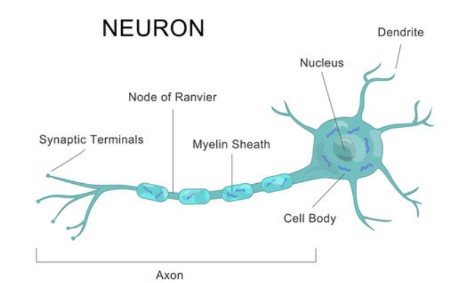
Explain the structure of neurons.
Answer
537.6k+ views
Hint: In this question we are going to explain the structure of neuron.Nervous system cells are called neurons. They have three distinct parts, including a cell body, axon, and dendrites. These parts help them to send and receive chemical and electrical signals.
Complete answer:
Let's discuss and find the answer.
1.The structure of neurons: Nerve cells or neurons are the structural and functional units of the nervous system. It consists of three major parts namely, cell body, dendrites, axon.
2.Cell Body: It is irregular in shape or polyhedral. It contains cytoplasm and certain granular bodies called Nissl's granules which contain a group of ribosomes for protein synthesis.
3.Dendrites: Dendrites are short fibers that branch repeatedly and protrude out of the cell body. They transmit electrical impulse towards the cyton.
4.Axon: They are long fibers arising from the cell body with a branched distal end. It terminates in a synaptic knob. It is filled with neurotransmitters.
5.Parts of axon:
a. Axoplasm: It is the cytoplasm of an axon.
b. Myelin sheath: It is made up of many layers of Schwann cells.
c. Neurilemma: The outermost layer of Schwann cells.
d. Nodes of Ranvier: These are gaps left by a myelin sheath.

Note: The neurons perform the function of receiving signals in the form of electrical impulses and they also perform the transmission of these impulses from the receptors or sensory organs to the central nervous system (CNS) and from the CNS to the target organs.
Complete answer:
Let's discuss and find the answer.
1.The structure of neurons: Nerve cells or neurons are the structural and functional units of the nervous system. It consists of three major parts namely, cell body, dendrites, axon.
2.Cell Body: It is irregular in shape or polyhedral. It contains cytoplasm and certain granular bodies called Nissl's granules which contain a group of ribosomes for protein synthesis.
3.Dendrites: Dendrites are short fibers that branch repeatedly and protrude out of the cell body. They transmit electrical impulse towards the cyton.
4.Axon: They are long fibers arising from the cell body with a branched distal end. It terminates in a synaptic knob. It is filled with neurotransmitters.
5.Parts of axon:
a. Axoplasm: It is the cytoplasm of an axon.
b. Myelin sheath: It is made up of many layers of Schwann cells.
c. Neurilemma: The outermost layer of Schwann cells.
d. Nodes of Ranvier: These are gaps left by a myelin sheath.

Note: The neurons perform the function of receiving signals in the form of electrical impulses and they also perform the transmission of these impulses from the receptors or sensory organs to the central nervous system (CNS) and from the CNS to the target organs.
Recently Updated Pages
Master Class 12 Business Studies: Engaging Questions & Answers for Success

Master Class 12 Economics: Engaging Questions & Answers for Success

Master Class 12 English: Engaging Questions & Answers for Success

Master Class 12 Maths: Engaging Questions & Answers for Success

Master Class 12 Social Science: Engaging Questions & Answers for Success

Master Class 12 Chemistry: Engaging Questions & Answers for Success

Trending doubts
What is meant by exothermic and endothermic reactions class 11 chemistry CBSE

Which animal has three hearts class 11 biology CBSE

10 examples of friction in our daily life

One Metric ton is equal to kg A 10000 B 1000 C 100 class 11 physics CBSE

1 Quintal is equal to a 110 kg b 10 kg c 100kg d 1000 class 11 physics CBSE

Difference Between Prokaryotic Cells and Eukaryotic Cells




